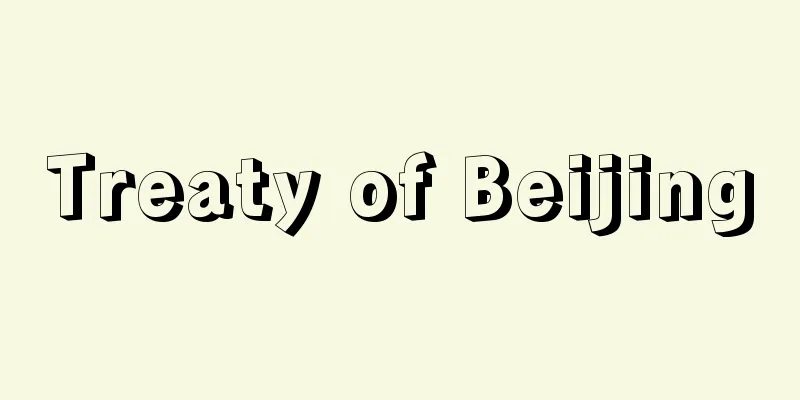Treaty of Beijing

|
A common name for over a dozen treaties that the Qing Dynasty concluded with foreign countries in Beijing, China. However, it does not include all treaties concluded in Beijing (the Xin Chou Protocol after the Boxer Rebellion is one example). The most famous are the three treaties concluded separately with Britain and France in October 1860, and Russia in November. The Qing-British and French-Chinese treaties ended the Arrow War (Second Opium War) that had been going on for 57 years, and confirmed the Treaty of Tianjin in 1858, as well as (1) increasing the indemnity stipulated in the Treaty of Tianjin (to 8 million taels each), (2) opening the port of Tianjin, (3) approving the recruitment and travel of Chinese laborers, (4) ceding the Kowloon Si area (the urban area at the southern tip of the Kowloon Peninsula) to Britain, and (5) approving the return of confiscated Catholic Church property to France. The Treaty of Beijing with Russia was concluded in response to Russian demands made by Russia, which had mediated peace between the Qing Dynasty and Britain and France. The Treaty of Aigun in 1858 awarded the coastal region east of the Ussuri River, which had been shared by both countries until the border was finalized, to Russian territory, and recognized Kulun, Kashgar, and Zhangjiakou as trading sites. The signing of the treaty in Beijing had been firmly rejected by the Qing dynasty, but Britain and France insisted on its realization, which led to the military occupation of Beijing, and this realization itself was a symbol of a qualitative change in the Qing dynasty's international status. In fact, the signing of this treaty marked a turning point for the Qing dynasty, as conservative xenophobic factions retreated due to a coup at court, and Prince Gong, who had been involved in the signing of the treaty, and others took the lead in establishing a specialized diplomatic agency (the Prime Minister's Office) and shifting to a policy of foreign relations and friendship. Britain and France supported the Qing dynasty and began to actively assist in the suppression of the Taiping Rebellion. [Shinji Kojima] Source: Shogakukan Encyclopedia Nipponica About Encyclopedia Nipponica Information | Legend |
|
中国、北京で清(しん)国が諸外国と結んだ十数種の条約の通称。ただし、北京で結ばれた条約すべてを含むものではない(義和団事件後の辛丑(しんちゅう)議定書はその一例)。もっとも有名なものは、1860年10月イギリス、フランスと、11月にロシアと個別に結んだ三つの条約である。清英、清仏間の条約は57年来のアロー戦争(第二次アヘン戦争)を終わらせたもので、58年の天津(てんしん)条約を確認したほか、〔1〕天津条約に規定された賠償の増額(各800万両(テール)へ)、〔2〕天津の開港、〔3〕中国人労働者の募集と渡航の承認、〔4〕イギリスの九竜司地方(九竜半島南端の市街地部分)の割譲、〔5〕没収したカトリック教会財産のフランスへの返還を承認した。ロシアとの北京条約は、ロシアが清と英仏との講和を斡旋(あっせん)したことから、ロシアの要求を受け入れて結ばれたもので、58年のアイグン(愛琿)条約で、国境確定まで両国で共有することとされていたウスリー川以東の沿海地方をロシア領とすること、クーロン、カシュガル、張家口を貿易地として認めることなどからなる。 北京での条約調印は、従来、清朝が固く拒否し、イギリス、フランスがその実現に固執して北京の軍事占領に至ったもので、この実現自体、清朝の国際的地位の質的変化の象徴であった。事実、清朝ではこの条約締結を機に、保守排外派が宮廷政変によって後退し、条約締結にあたった恭親王奕訢(えききん)らが中心となって、外交の専門機関(総理各国事務衙門(がもん))を設立して、対外和親政策に転換し、イギリス、フランス両国は清朝を支持して、その太平天国鎮圧を積極的に援助するようになった。 [小島晋治] 出典 小学館 日本大百科全書(ニッポニカ)日本大百科全書(ニッポニカ)について 情報 | 凡例 |
<<: Peking University - Peking University
Recommend
Tadamichi Ina
?-1756 A samurai from the mid-Edo period. A shogu...
Ryokan
A poet and Chinese poet of the late Edo period. H...
Hiligaynon
...(1) Western Visayan languages: Aklanon (about ...
distinctive feature
… /t/ voiceless, alveolar, stop /d/ voiced, alveo...
Mrs. Ellis
…Furthermore, home economics books themselves cha...
Ducted propeller
Also called a nozzle propeller. A circular duct is...
Le Charivari
A French satirical newspaper founded on December 1...
ape hand (English spelling)
…Single paralysis caused by peripheral nerve dama...
Sur la pointe (English spelling) sur la pointe
…The first male dancer is the Premier Dansour. Po...
Boise (English spelling)
Located in western Idaho, Idaho is the state capit...
Heavy hitting - heavy hitting
〘Noun〙 A type of punishment in the Edo period. It ...
Tax haven (English spelling)
Also called a tax haven or tax haven. There are ma...
Heavenly King - Tenno
Tenno-machi was formerly a town in Minamiakita Co...
Willem de Sitter
1872‐1934 Also known as de Sitter, he was a Dutch ...
coal pick
...The coal mining capacity is 4 to 6 tons per mi...









